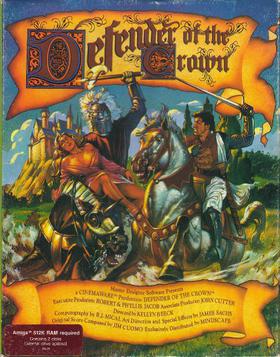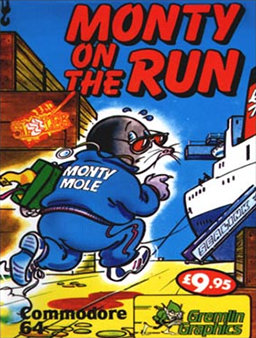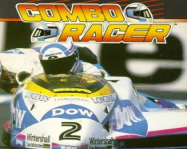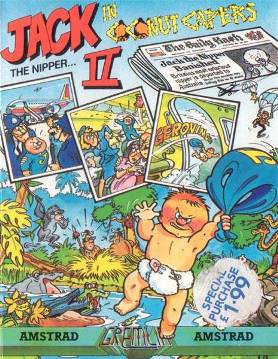
Shadow of the Beast is a platform game developed by Reflections and published by Psygnosis in 1989. The original version was released for the Amiga, and was later ported to many other systems. The game was known for its graphics, with many colours on screen and up to twelve levels of parallax scrolling backdrops, and for its atmospheric score composed by David Whittaker that used high-quality instrument samples.

Wonder Boy in Monster Land, known by its original arcade release as Wonder Boy: Monster Land, is a platform video game developed by Westone Bit Entertainment and released by Sega in Japanese arcades in 1987 and for the Master System in 1988, with a number of other home computer and console ports following. The game is the sequel to the 1986 game Wonder Boy and takes place eleven years after the events in the previous game. After enjoying over a decade of peace on Wonder Land following the defeat of the evil King by Tom-Tom, later bestowed the title "Wonder Boy", a fire-breathing dragon called the MEKA dragon appeared; he and his minions conquered Wonder Land, turning it into "Monster Land". The people, helpless due to their lack of fighting skill, call for Wonder Boy, now a teenager, to destroy the monsters and defeat the MEKA dragon. Players control Wonder Boy through twelve linear levels as he makes his way through Monster Land to find and defeat the MEKA dragon. Players earn gold by defeating enemies and buy weapons, armor, footwear, magic, and other items to help along the way.

Defender of the Crown is a strategy video game designed by Kellyn Beeck. It was Cinemaware's first game, and was originally released for the Commodore Amiga in 1986, setting a new standard for graphic quality in home computer games.

Gremlin Graphics Software Limited, later Gremlin Interactive Limited and ultimately Infogrames Studios Limited was a British software house based in Sheffield, working mostly in the home computer market. Like many software houses established in the 1980s, their primary market was the 8-bit range of computers such as the ZX Spectrum, Amstrad CPC, MSX, Commodore 16 and Commodore 64. The company was acquired by French video game publisher Infogrames in 1999 and was renamed Infogrames Studios in 2000. Infogrames Studios closed down in 2003.
The following article is a broad timeline of arcade video games.

Rush'n Attack, also known as Green Beret in Japan and Europe, is a run-and-gun and hack-and-slash video game developed and released by Konami for arcades in 1985, and later converted to the Nintendo Entertainment System and home computers. Its North American title is a play on the phrase "Russian attack" due to its Cold War setting. It was ported to home systems and became a critical and commercial success for arcades and home computers.
Actua Sports is a sports video game series published by Gremlin Interactive which competed with Electronic Arts EA Sports label during the second half of the 1990s, until Gremlin was acquired by Infogrames. The term "Actua" is a play on Sega's line of "Virtua" titled games, which included Virtua Fighter, Virtua Racing and Virtua Striker.

Hogs of War is a 2000 turn-based tactics video game developed by Infogrames Sheffield House and published by Infogrames for the PlayStation and Microsoft Windows. The game is set in the First World War-era where anthropomorphic pigs engage in combat. Hogs of War features 3D graphics and both a single-player career mode and offline multiplayer, with voice artistry by British comedic actors Rik Mayall and Marc Silk.

Monty on the Run is a computer game created by the software house Gremlin Graphics and released in 1985 for the Commodore 64, ZX Spectrum, Amstrad CPC and Commodore 16, written by Peter Harrap for the ZX Spectrum with the iconic in-game music on the Commodore 64 provided by Rob Hubbard. It is the third game in the Monty Mole series.

Ben Daglish was an English composer and musician. Born in London, his parents moved to Sheffield when he was one year old. He was known for creating many soundtracks for home computer games during the 1980s, including such as The Last Ninja, Trap, Krakout, and Deflektor. Daglish teamed up with fellow C64 musician and prolific programmer Tony Crowther, forming W.E.M.U.S.I.C., which stood for "We Make Use of Sound in Computers". Daglish had attended the same school as Crowther. Daglish mostly worked freelance but was employed by Gremlin Graphics for a couple of years.
Vortex Software was a video game developer founded by Costa Panayi and Paul Canter in the early 1980s to sell the game Cosmos which Panayi had developed for the Sinclair ZX81. They converted the game to the ZX Spectrum, but due to the low sales of the ZX81 version they licensed the game to Abbex.

Jungle Strike is a video game developed and published by Electronic Arts in 1993 for the Sega Genesis. The game was later released on several other consoles such as the Super Nintendo Entertainment System (SNES), and an upgraded version was made for DOS computers. The Amiga conversion was the responsibility of Ocean Software while the SNES and PC DOS versions were that of Gremlin Interactive, and the portable console versions were of Black Pearl Software. It is the direct sequel to Desert Strike and is the second installment in the Strike series. The game is a helicopter-based shoot 'em up, mixing action and strategy. The plot concerns two villains intent on destroying Washington, D.C. The player must use the helicopter and occasionally other vehicles to thwart their plans.

Impossamole is a platform game developed by Core Design for the Amiga, Atari ST, Commodore 64, Amstrad CPC and ZX Spectrum. It was released in 1990 and published by Gremlin Graphics. NEC Technologies published it on TurboGrafx-16 the following year. It is the sixth and final game in the Monty Mole series.
Imagitec Design was a video games development company founded in 1989, based in the UK. The main person involved was Barry Leitch, who worked as a composer for many of the company's soundtracks.
Barry Leitch is a Scottish video game music composer. His work includes the Lotus Turbo Challenge, TFX, Gauntlet Legends, Gauntlet Dark Legacy, Top Gear, and Rush video game series.

Combo Racer is a Sidecar video game developed by Imagetic Design and published by Gremlin Graphics in 1990. The game uses an isometric view and the player has to change gear manually. It contains a training mode, a normal game mode and a track editor.

Jack the Nipper II: In Coconut Capers is a video game by Gremlin Graphics released in 1987 for ZX Spectrum, Commodore 64, Amstrad CPC, and MSX. It is the sequel to Jack the Nipper. As with the previous game, Jack the Nipper II is a side-view flip screen game with puzzle solving and platform elements. The false-3D effect has been removed, making the gameplay pure 2D.

Human Killing Machine is a 2D fighting video game. The game was developed by British company Tiertex, who hired external team Blue Turtle to produce the graphics, and published by U.S. Gold, released in March 1989. It was touted as a sequel to Tiertex's home computer conversion of Street Fighter. It was released for 8-bit and 16-bit home computer formats.

Switchblade is a 1989 side-scrolling action-platform run and gun video game originally developed by Core Design and published by Gremlin Graphics in Europe for the Atari ST home computers. The first installment in the eponymous two-part series, the game is set in a dystopian future where players assume the role of Hiro from the Blade Knights as he embarks on a journey to defeat Havok, the main antagonist who broke free from his imprisonment after the sacred Fireblade was shattered into several pieces. Its gameplay consists of run and gun action mixed with platforming and exploration elements, with a main single-button configuration.














